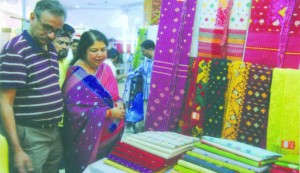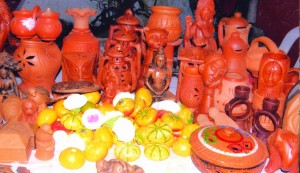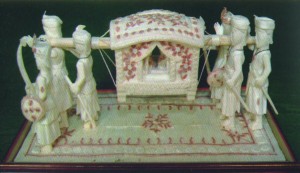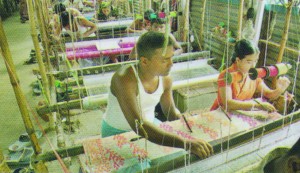From very dawn of civilization the human being profusely perceived the use of goods and chattel machines and many other materials as a daily essential. From ages the usefulness of handiworks added with these essential household articles that made the essentials more pleasing and worth attracting. In order to materializing all these senses of woodcrafts, a human-entity of rare beauty gives birth in the inborn faculty which otherwise known to be the entity of the artisan. By using this entity of artisan it has created all that uncommon wooden crafts that subsequently has become the necessary attachments of everyday life of human being from generation to generation.
The handicrafts of the Bengal were cordially received by across the world from the very ancient time as part of continuance in blossoming the bewitching handicrafts. In that time the handicrafts of Bengal was able to leave behind its footprints to all prosperous civilization including Egyptian civilization. The muslins and earthen works of the Bengal even in that time were exported to many countries of the world.
The handicrafts of Bengal first initiated by generically succession and these capabilities transformed down to the descending heredity by time-age adopting as family occupation. That’s why still it can be said that the quality of this craft is almost without any prejudice and in many cases it gained further improvement. This industry has been elevated to a considerable height for easy availability of raw goods as well as the simple productions method on the basis of geographical diversification of the country. Thus different handicrafts are blossomed by zone wise. They include weaving industry, wooden industry, earthen industry, leather, jute goods, cane, bamboo and fiber industries etc.
Bangladesh has created a huge market of latest products of handicrafts with diversity having world class quality and many of these products are exported abroad now-a-days. The number of various kinds of handicrafts soared gradually which has been shown as under sub-sector. These are:
1. Handloom products: Jamdani saree, Silk saree, Benarasi saree, Tangail saree, Monipuri textiles and many other considerable handloom products.
2. Textile products: Embroider quilt, canvas made, bag, bed cover, cushion, block, boutique, screen printed product, echlin product, etc.
3. Leather goods: Moneybag, office bag, file bag, lady’s bag, purse, key bag, travel bag, photo frame, showpiece, shoe, sandal, etc.
4. Wooden products: Flower vase, tray, photo frame, ash tray, pen holder, mascot, showpiece, etc.
5. Bamboo goods: Basket, flute, flower vase, tray, ash tray, tray, light shade, Showpiece, etc.
6. Cane goods: packet, chair, table furniture, book shelf, flower vase, table lamp, show piece, etc.
7. Earthen products: Earthen tray, flower vase, flower tube, ash tray, pencil holder, doll, toy, vassal, etc
8. Jute goods: Bag, wall-mat, carpet , door-mat, nursery, bag, jute-bell, table lamp, showpiece, etc.
9. Metal industrial products: Utensils, brass, white products, button , wall-mat, vanity bag, pen holder, Showpiece, etc.
10. Fiber goods: Hat of palm fiber, fiber basket, mat, table-mat, wall-mat, jainamaj, cool-mat, rape and net, bag, showpiece, etc.

Speaker of Bangladesh National Parliament Dr. Shirin Sharmin Chowdhury is visiting Jamdani Fair held at National Museum, Dhaka.
These handiworks are of two kinds- one being the tradition based and the other is a new creation. By implementing handicraft rules and regulations, the consistency of the two can diversify with great éclat of variety of products. In 2015 a rule was framed for fast growth and blossoming handicraft sector. In order to implementing these rules and principles, BSCIC is working as sponsoring authority of the handicraft sector which is playing a pioneer role in extending legal support, providing training to the entrepreneurs, assistance by drawing design and technology, marketing and credit facilities including coordination and monitoring.
Other departments, bodies or organizations (Trade Organizations) have effective roles in this respect, such as Patent Design and Directorate of Trade Mark (DPDT) registrations and Trademark certification of geographical indication (GI) products. BSTI works for the quality and certification of the products, National Board of Revenue (NBR) for the fiscal incentives, Ministry of Commerce for marketing incentives, Ministry of Foreign Affairs for exploration of market of handicrafts abroad, Export Promotion Bureau (EPB) for exploration and participation in fair facilities. Chamber, NASCIB and Bangla Craft work for organizing fair, creating promoters and means. Youth Development Directorate works for getting together of artisans of handicraft, creating entrepreneurs’ training , credit flow and market linkage together with Social Welfare Directorate, Bangladesh Handloom Board, Bangladesh Sericulture Board, Bangladesh Lok-o-Karm Shilpoo Foundation. The issuance of trade licence for the handicraft artisans to carry on thier trade, the role of Local goverment for founding karupalli handicraft village) and CFC (Common Facilitating Centre), involvement of City Corporations, Pourashavas and Union Parishads are of paramount importance.
In order to go ahead with this industrial sector as a whole, dynamic and effective participations by the organizations/bodies including BSCIC are very useful at this time as because the acts of well reorganization of the groups entangled with this industry, reviving and marketing of their products and protection of indications are a must. For this various programmes have been undertaken in order to transform the handicrafts rules in the action plan.
The action plan/program includes opening a showroom of handicrafts in all airports, organizing exhibition and fair of handicrafts in all the diplomatic missions of Bangladesh abroad.
Bscic aims at mapping handicrafts, improvement products’ quality and design, collection of new technology and design, improvement of training and skills of the handicraft artisans, diversification of products and improvement of standards, founding handicrafts village, capacity building of entrepreneurs, preparation of an integrated catalogue of handicraft products and updating, participation of artisans/designers of handicrafts in overseas fairs, etc.
The major feature of handicrafts is that it upholds the national cultural heritage of the country. Even in blossoming tourism industry, it plays a subsidiary role because of which the government has undertaken initiatives to assist the designers by offering legally a fiscal incentive, compelling an information store as well as an archive, handicraft based development research designing patterns, design and collection.
Moreover, effective marketing programme, i.e. a massive programme of undertaking actions for incentive is in considerations to be implemented by stressing for branding handicraft products through organizing fair and exhibitions across the country by declaration of a national craft day in the year and distributing the national best craft designer award, etc.
The craft products now-a-days are getting popular persistently at home and abroad and the volume of market is also expending day by day. To blossom this trend institutionally, we need to create skilled promoters and for that a massive program is undertaken to provide training program aiming at improving skills. BSCIC Design Centre, Jute Diversification Promotion Centre (JPDC), Chamber, NASIB, Bangla Craft, SME Foundation, Lok-O-Karu Shilpa Foundation organis training workshops in this respect aiming to reach the goal of making multilateral and diversified handicrafts industry. It is also taken into consideration for further development through new design and technology for jute goods sector. For this, a fashion design training institute is founded in Narsingdi, in an enriched handloom zone and a craft training institute and museum is expected to be established in Dhamrai, not far away from Dhaka.
Jamdani is the foremost traditional craft as one of the most notable cultural heritages of Bangladesh which in the meantime has been registered as the first GI product. From the ancient time it developed and blossomed in Narayanganj which is still in production in more than fifteen hundred industrial units and several thousand weavers are working there. Its market is also expanding. Every year Jamdani Fair takes place in Dhaka and Chittagong organized by BSCIC. For flourishing the Jamdani industry, a Jamdani Industrial Estate was founded in the Noapara village of Tarabo union in Rupganj of Narayangain with a goal of extending marketing assistance and boosting productivity including assurance of standard quality of Jamdani items by the artistic craft designers of new generation. Besides this, the craft designers and artists are provided with infrastructural benefits and the entrepreneurs are rehabilitated here. Their socio-economic way of life is modernized and they now refrained from changing profession.
Another cultural heritage of Bangladesh is the most notable craft Satranji that has been in production for hundreds of years and marketed at home and abroad and gradually the volume of this market is getting expanded. Basically this industry first introduced and developed in the areas of Nishbethganj and Radha Krishnapur of Rangpur Sadar. This product has a market as many as in 36 countries at this period of time where it is exported. This industry has a strength of about 5000 skilled workers, technicians and promoters who are directly involved with this sector. Once it was extinguished and afterwards a major plan was taken for revival of this dead traditional sector by BSCIC and subsequently one Mr. Md. Shafiqul Alam Selim came forward and revived this traditional craft under the title and name “Karupanya Rangpur Limited” and they went on production of Satranji under this name. Various countries of the world are consuming his products.
Now the Satranji is under process for registration as a GI product. BSCIC is now implementing the process for getting GI of Satranji. The development program of Satranji industry and also Benarasi Saree development program in Rangpur district are running under the supervision of BSCIC.
Moreover, the name and fame of our Nokshi Kantha, Khadi Cloth, jute goods, earthen industry, metal industry, wooden industry, care mat, palm hat, boutique, etc have spread far and wide at home and abroad. The productivity as well as the consumption of them has been grown persistently. All these are the own assets and intellectual properties of Bangladesh as well as our cultural heritage. By using sustainable local technology and own raw goods these commodities have been in production from ages. At the present open market and age of global economy, our crafts market has been expanding in the global market and the horizon in respect of new markets is getting widened under a competitive process of global trade. This ushers in a new hope for SCI sector and the country as a whole.















